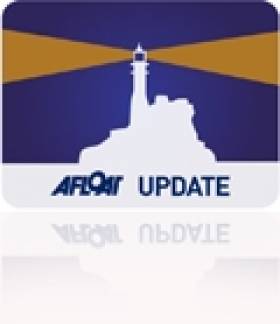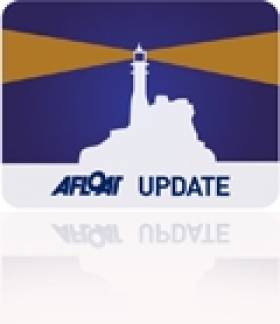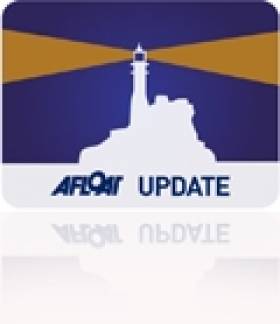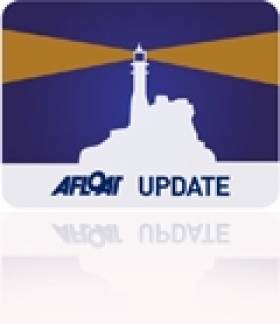Displaying items by tag: Fastnet
2015 Sailing Calendar Includes Two Bicentenaries & Ireland's Biggest Regatta At Dun Laoghaire
Irishsailing – After the remarkable across-the-board success of the 2014 Irish sailing season, 2015 will have to be very special indeed to be remembered with such enthusiasm. But it's a special year in any case, as two major sailing Bicentenaries – one in the Irish Sea, the other in the Solent – will have added and poignant meaning, as the Centenaries a hundred years ago could not be celebrated because of the First World War.
As for Irish sailing generally, life moves on, there are new sailors on the water, successful young sailors are graduating to the next stage of their rapidly developing careers, and established stars continue to plan fresh campaigns, for sailing is indeed a sport for life.
Then too, new fixtures successfully introduced in 2014 will require nurturing, tuning and encouragement if they are to fulfil their potential in the coming year, while at the same time there's always extra effort needed to give proper support to established fixtures, which have to live with the reality that they might wilt through being taken for granted. Both new and longer-established boat classes will need continued enthusiastic involvement, and our well-loved classics and traditional craft must be cherished and sailed, for lack of use is the real enemy of boats, whether old or new.
As for the major administrative initiatives introduced in 2014, they will need constant monitoring, but deserve full support from the sailing and boating community at large, for it was in response to a grass-roots initiative that the radical and very necessary reforms of the Irish Sailing Association were undertaken. Those appointed to undertake the root-and-branch reform of the national authority have done so with commendable dispatch, so it is now the duty of the rest of us to support their continuing efforts. And we can best do that by enjoying our boats and our sailing and time afloat in its myriad of interests, while encouraging others to do the same. W M Nixon outlines on what the coming year may bring.
One thing at least is certain for the coming season afloat during 2015 in most of Europe. It will not mark any significant sailing Centenaries. Instead, we are immersed in four years of remembering the Great War of 1914-1918 a hundred years on, with all the added twists of that period's longer historical narrative in Ireland. In such a context, it may seem frivolous to point out that sports like yachting have no great Centenaries to mark at all in 2015. But this minor off-screen fact is a reminder of the all-involving horror and obscenity of total warfare on an industrial scale. It obliterated anything like normal life.
Yet as recreational sailing had been going on in some sort of organised form for hundreds of years – albeit in a fairly rudimentary way in its earliest years in the 16th Century – there may well have been several important dates to be marked during the time of the Great War itself, but they were allowed to pass as there was no sport afloat, while civilian life ashore was very subdued.
And in Ireland, with the Troubles persisting for four years after the end of the Great War until 1922, the Bicentenary of the Royal Cork Yacht Club in 1920 was to be a muted affair – the official History of the Royal Cork Yacht Club (published 2005) tells us: "Plans for a special dinner to celebrate the club's bicentenary in 1920 had to be cancelled, probably because of the disturbed conditions in the country"
So the idea of celebrating the Centenary of the Royal Yacht Squadron in Cowes in 1915 at the height of the international war - other than in a rather solemn shorebound way - would have been unthinkable. But that in turn fuels the celebrations when the peacefulgood times roll again. Thus the Royal Cork Yacht Club, having been unable to celebrate its Bicentenary in 1920, went on to have a fabulous two-year Quarter Millennium celebration in 1969-70. And as the RYS couldn't have a proper party in 1915, there's no doubt that the up-coming Bicentenary in 2015 will be the nucleus of international sailing's megafest-of-the-year.
There are of course several clubs which pre-dated the Squadron when it was founded in 1815. And there are many whose members outshine the small membership of the RYS in the breadth and energy of their sailing. But for 2015, let's just acknowledge that the prestigious Squadron has been at the heart of sailing history for a very long time, while their clubhouse's location right on the Solent at Cowes is so central that when any great Solent-related events are under way, the Squadron is in the middle of the story.
Thus it was on the Squadron lawn that in July that the Irish team celebrated their epic Commodore's Cup victory at the end of July 2014. And it will be towards the Squadron and its Bicentenary that the fleet will be racing in 2015's west-east Transatlantic Race. And then it will be the firing of the cannons from the historic Squadron battery which will signal the start of the 46th Fastnet Race on 16th August 2015.
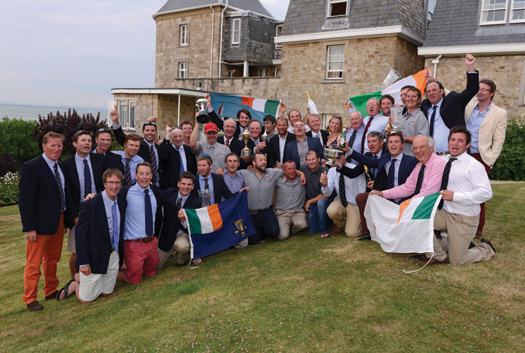
Party time at the Royal Yacht Squadron – the Irish team and their management gather to celebrate victory in the Commodore's Cup at the Squadron Castle in Cowes on August 1st 2014
There'll be many Irish boats involved, and the best-placed of them at the finish will be the winner of the Gull Salver, currently held by Martin Breen's Reflex 38 Lynx from Galway Bay SC, which was skippered to success by Aodhan FitzGerald in 2013's race. It's a coveted trophy, instituted to honour the memory of Harry Donegan of Cork and his famous cutter Gull, which was one of seven boats which inaugurated the Fastnet Race in 1925, and placed third. Since then, Irish Fastneteers have frequently been in the great race's top places, and best of all was in 2007 when Ger O'Rourke's Cookson 50 Chieftain out of Kilrush, sailing under the burgee of the revived Royal Western of Ireland YC, came sweeping in to the finish line at Plymouth to win the Fastnet Race
overall.
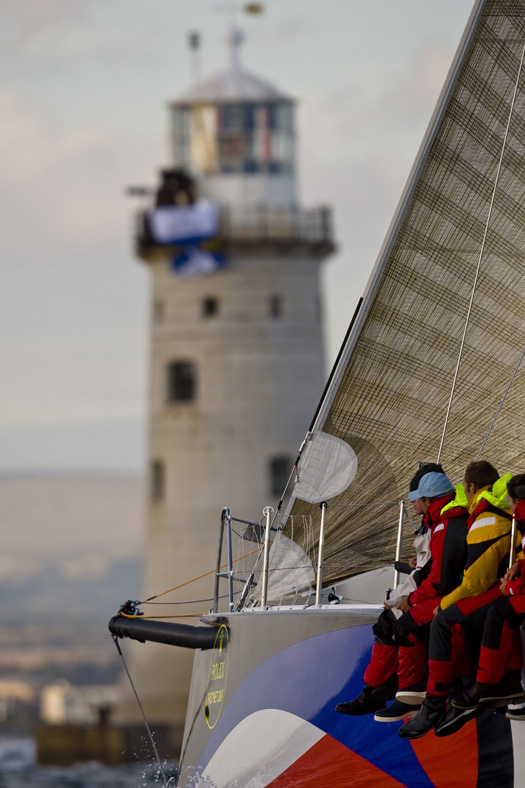
One of the greatest moments in Irish sailing history – Ger O'Rourke's Chieftain sweeps towards the finish line to become the overall winner of the Rolex Fastnet Race 2007. Photo: Rolex
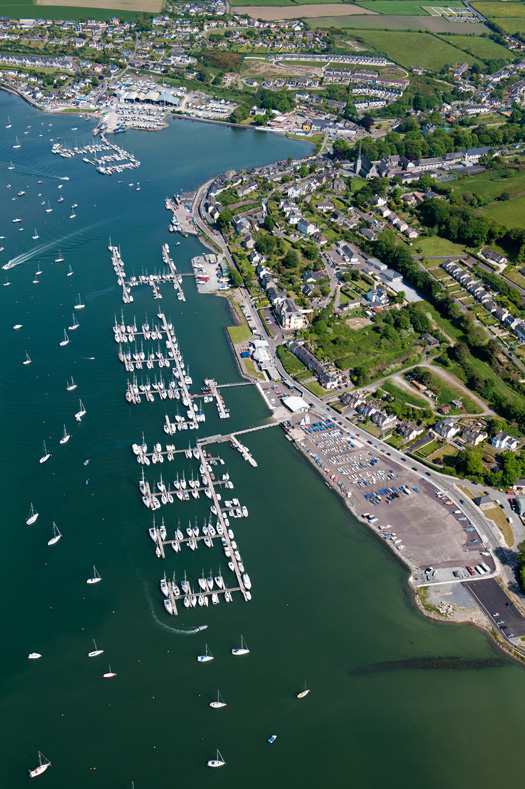
Just the spot for a great Tricentenary celebration - the very complete sailing facilities provided jointly by the Royal Cork Yacht Club and Crosshaven will become a world focus in 2020 with the Club's 300th anniversary. Photo: Bob Bateman
The realisation that 2015 sees this significant RYS Bicentenary is a timely reminder that the Royal Cork's Tricentenary is only five years down the line. They're five years which will be gone in a flash, and already behind-the-scenes moves are afoot to ensure that the national sailing programme will properly facilitate the extraordinary anniversary being celebrated in Crosshaven in 2020.
But meanwhile other Irish sailing centres have their own regular programmes to operate in the intervening four years, and in terms of numbers and scale there's no doubt the top event in Ireland in 2015 will be the biennial Volvo Dun Laoghaire Regatta from 9th to 12th July.
Anyone – and there were many - who took part in this unique "suburban sailfest" in 2013 will know that the VDLR has come of age. It's an event which is comfortable with itself while at the same time being always in development and evolution mode. Each staging of this remarkable Dublin Bay happening sees lessons being learnt and implemented even while the multi-class racing is under way on several courses. And in the two year gap before the next staging, the experience gained is closely analysed and the programme refined to further improve the sport in every area.
You get some idea of the sheer depth of racing experience in Dun Laoghaire by noting that the Chairman of the 2015 Committee is Tim Goodbody, with Martin Byrne as Vice Chairman while the Race Director is Con Murphy. And those three sailing megastars are just the peak of a mountain of race administration experience which is being drawn in from all over Ireland to ensure that the fleet of 400-plus boats gets the best sport possible.
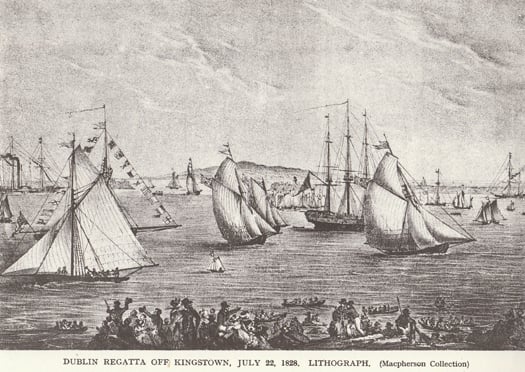
The first regatta in 1828 at the new harbour at Dun Laoghaire, which will be the setting for Ireland's biggest event in 2015, the Volvo Dun Laoghaire Regatta from 9th to 12th July.
While there'll be keenly participating boats from all over Ireland as well as Scotland, England and Wales, the setup of Dublin Bay being right on the city's doorstep means that it's the locals who would pose an administrative problem for a less experienced team. As the dates for the VDLR approached in 2013, the weather forecast steadily improved, and thanks to the Regatta's "extra long weekend" format, the sudden arrival of summer meant that a host of boats from the greater Dublin area came in as last minute entries, their owners and crews managing to scrape the extra day-and-a-half needed off work. It's a scenario which would put an overstretched administration off course, but the VDLR team took it calmly in their stride, and the result was a successful summer festival of sunlit sails and great sport, with maybe two thousand taking part.
This year there's a more structured cross-channel involvement, as the venerable Royal Dee YC in Cheshire has leapt to life to celebrate its Bicentenary. Founded as the Dee Yacht Club in 1815 with the end of the Napoleonic Wars, it didn't get the Royal seal until 1947, but nevertheless claims to be older than the RYS. With growing fleets in North Wales and the Mersey, it has put together a Bicentennial Royal Dee Irish Sea Offshore Championship linked closely to ISORA, which will bring the fleet across to Ireland to take in four offshore day races sailed as part of VDLR 2015.
Irish National Championships which will be part of the VDLR 2015 programme include the J/109s, the RS Elites, the Beneteau First 21s, and the Wayfarers, while the Leinster GP 14 Championship is also included as an integral part of the Regatta.
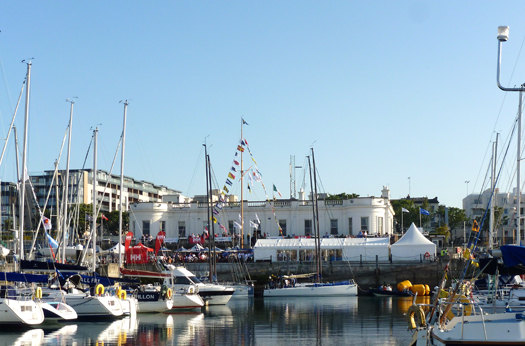
Party time in Dun Laoghaire – the Royal Irish YC during VDLR 2013. Photo: W M Nixon
As for Ireland's classic clinker-built vintage classes, one of the pleasantest surprises in VDLR 2013 was the large turnout of Mermaids, which had superb racing on the course area in the northwest corner of Dublin Bay. Despite having been born as the Dublin Bay SC Mermaid in 1932, this class of 17ft super-dinghies is no longer included in the regular DBSC programme owing to shortage of numbers for weekly turnouts. But it seems that as far as the VDLR is concerned, the Mermaid is now an event boat, and the fleets still thriving at other centres, together with some of the dormant Dublin Bay craft, bestirred themselves for the four days to enjoy good sailing for more than three dozen boats, something which is highly likely to be repeated in 2015.
The even more venerable Water Wags, founded 1887 with the current boats dating from 1903, continue to thrive in Dun Laoghaire, and the word is they expect to have at least twenty boats in action, while another wooden classic, the Mylne-designed 25ft Glen keelboat, is 50 years and more in Dun Laoghaire, and looks forward to having at least twelve boats racing in 2015.
All these specialized and historic classes are in addition to the numerous cruiser-racers which continue to be the backbone of Dublin Bay sailing. And while many of them will see the VDLR 2015 as a highlight of the year, in turning to consider the overall national programme, we find a sport which is shaking off economic recession to get on with an extraordinary plethora of local, national and international sailing events.
The problem is that most events of significance hope to locate themselves in the peak sailing period from late May to early September, so clashes are almost inevitable, and if you're interested in several different kinds of sailing, the overall choices can be bewildering in their complexity and logistical challenges.
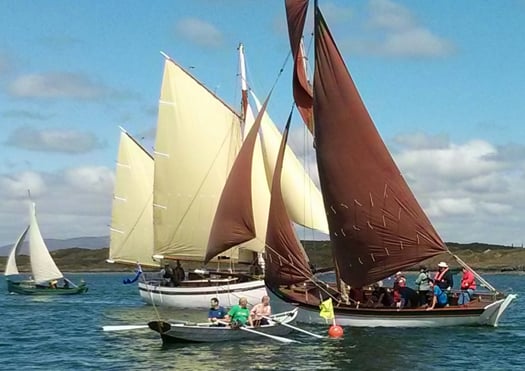
The Baltimore Wooden Boat Festival attracts an eclectic fleet – included here are a Shannon Gandelow, a West Cork Mackerel Yawl, the ketch Sile a Do, and an Heir Island Lobster Yawl (left).
For instance, the variety of events now available for the traditional and classic boats – usually but not necessarily under the Old Gaffer umbrella – would keep anyone busy for most of the summer. It starts with the Baltimore Wooden Boat & Seafood Festival from Friday 22nd May to Sunday 24th May, which you'd think very early
in the season for someone faced with fitting out an old wooden boat in Ireland's climate, but somehow they do it.
Then on the East Coast for the early summer Bank Holiday Weekend from May 29th to June 2nd, there's the Old Gaffer gathering in Dublin Bay at Poolbeg Y&BC with the annual race for the Leinster Trophy in the bay on Saturday May 30th, the event then morphs into the Dublin Port Riverfest in the Liffey on Sunday May 31st, and finally it all concludes with the race for the Asgard Trophy back in the bay on Monday June 1st.
The annual Lambay Race at Howth, a regular fixture since 1904, has seen its course becoming increasingly complex in modern times in order to satisfy the desire of modern racers for competition on every possible point of sailing. But in 2014, to celebrate the Centenary of the Lynch family's Echo, the venerable Howth Seventeens were sent on the traditional course north from Howth Harbour through the sound inside Ireland's Eye, then on round Lambay leaving it to port, and then back south inside Ireland's Eye again to the finish at Howth pierheads.
This was such an attractive proposition for Old Gaffers and Seventeens alike that on the day an extra Classics Division was added to cater for ancient craft, and it hit the spot. This option will be offered again for 2015's Lambay Race (it's on Saturday June 6th), and the word is that Dickie Gomes's 1912-built 36ft yawl Ainmara will be coming down from Strangford Lough to defend her title after 94 years. 94 years? Yes indeed - she won the Lambay Race in spectacular style in 1921 when still under the ownership of her designer-builder John B Kearney.
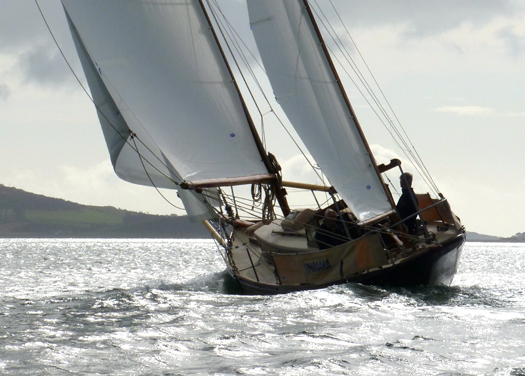
After 94 years, Dickie Gomes's 36ft 1912-built yawl Ainmara (seen here on her home waters of Strangford Lough) hopes to return to defend the title in Howth's Lambay Race, which Ainmara won in 1921 while still in the ownership of her designer-builder John B Kearney. Photo: W M Nixon
The Old Gaffers attention then swings north as the Tall Ships are coming to Belfast from Thursday 2nd July to Sunday 5th July. This is going to be a serious biggie with those ships already signed up including a significant turnout of Class A vessels, which are square riggers and others of more than 40 metres in length. Belfast Lough lends itself particularly well to the Parade of Sail which follows a Tall Ships gathering, and in 2009 when they were last in the port they put in in a virtuoso display with the Dutch ship Europa in particular going to the trouble of getting herself over towards Whiteabbey in the northwest corner of the lough to allow her time get every stitch of sail set before proceeding seawards down-lough in colossal style, a much more impressive display than we've become accustomed to in Dublin, where the shape of Dublin Bay is such that it doesn't really provide the space for square riggers to set all cloth before getting out to sea.
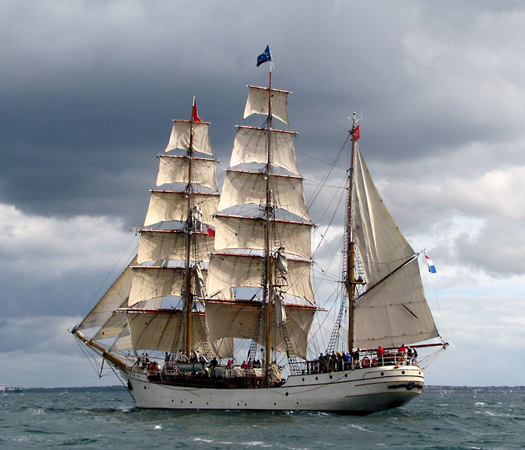
The Tall Ship Europa shows how it should be done in Belfast Lough in 2009, taking time out to set full sail before she starts to gather power to make the proper input into the Parade of Sail.
Like Dublin, Belfast has shown it can be hospitable to Old Gaffers, and it was a very welcoming main port during the OGA Golden Jubilee Cruise-in-Company in 2013, so for 2015 the OGA National President Sean Walsh hopes to up the ante by persuading his members from all round the Irish Sea to gather in Belfast, and to add spice to the mix, he hopes to persuade the Howth 17s to put in an appearance as well, to sail with local one designs like the 1903 Belfast Lough Waverley Class, which have been experiencing a revival in recent years.

Old Gaffers in Belfast for their Golden Jubilee in 2013. The Irish Sea classic and traditional fleet will return to the same venue for the Tall Ships gathering in July 2015. Photo: W M Nixon
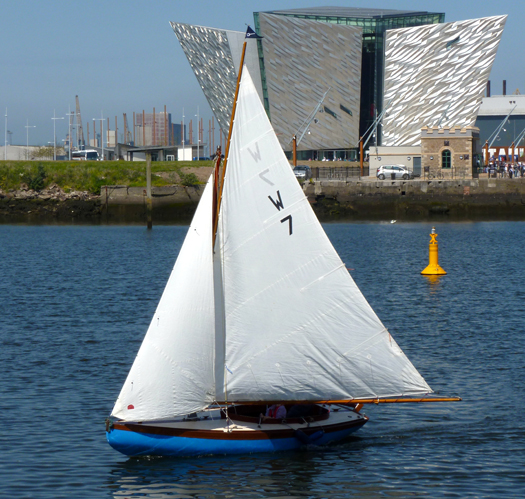
The Belfast Lough Waverley Class Lilias (built 1903) sailing at the Titanic Centre in Belfast. In 2015, the Waverleys will be joined by some of the 117-year-old Howth 17s to participate in the visit of the Tall Ships. Photo: W M Nixon
The Seventeens have made long treks as a class before – in 1998, five of them were road-trailed to Carrickfergus to mark the class's Centenary, with the first five boats built by Hilditch of Carrickfergus. So though they'd trailed there, they then sailed the 90 miles back to Howth, just as the first boats had done a hundred years earlier. Then in July 2003, fifteen of the Seventeens took part in the Glandore Classics Regatta thanks to a brilliantly organised exercise in logistics using a flotilla of low loaders which could take three boats apiece.
For all of Ireland's classic and traditional boats in 2015, and an international fleet too, Glandore is very much up on the radar again, as a special effort is being made by a GHYC team led by Donal Lynch to encourage increased numbers in the CH Marine Glandore Classic Regatta from Saturday July 18th through Friday July 24th. It's a date which certainly allows Old Gaffers plenty of time to get down from Belfast, indeed some may even consider the option of making the voyage northabout to take in a round Ireland cruise while they're at it. And as that great magnet of the Irish Sea classic and traditional scene, the Peel Traditional Boat Weekend, isn't until Friday 31st July to Sunday 2nd August, it's just about possible to factor that in as well.
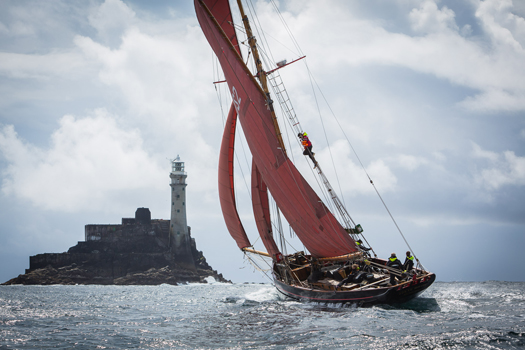
Everything happening at once – the famous Pilot Cutter Jolie Brise was the star of the Glandore Classics in 2013, and as it was her own Centenary she celebrated by sailing round the Fastnet Rock – she has been a successful Fastnet Race participant several times. Photo: Brian Carlin
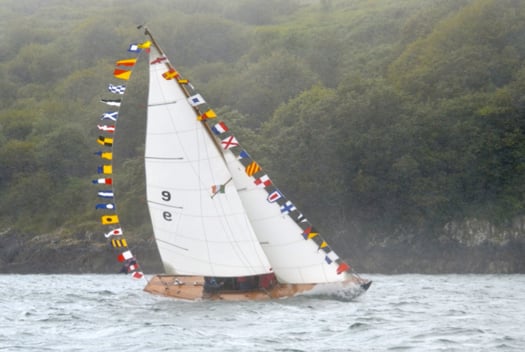
The Glandore Classics attracts an international fleet, and 2013's regatta included a class of Fife One Designs from the Menai Straits, all of them keen to party and showing it. 2015's Glandore Classics is from July 18th to 24th. Photo: Cormac O'Carroll
All this is already happening for the oldies with August barely under way, yet for modern cruiser-racers the potential programme for any keenly-sailed Irish boat is equally complex, attractive and challenging. The season starts as usual with the Scottish Series from Friday 23rd May to Monday 26th May – there'll probably still be snow on the mountains of Arran. They've gone back to their roots by starting with a feeder race from Gourock to the main regatta centre at Tarbert on Loch Fyne. "Going back to the roots" is something of a theme for this year's staging of the Clyde Cruising Club's main racing event, as this is the 40th Scottish Series. Come to think of it, there are so many important 40th anniversaries happening in sailing these days that we have the admit that the decade which brought us the full horror of wide lapels and flared trousers also contributed some lasting elements of the international sailing scene, indeed it could be said that the modern era in sailing really began about forty years ago.
Back in Ireland, the ISORA programme will be well under way by June, while the Lambay Race on June 6th can be looked at with more interest by several boats, as the biennial National YC Dun Laoghaire to Dingle Race doesn't start until Friday June 12th . Last time round, there was a total fixtures clash between the two events, but in times before that hyper-keen sailors such as the Tyrrells of Arklow with Aquelina have been able to fit in both, indeed one year they did it so well they won both too, and were rightly acclaimed as the Afloat "Sailors of the Month" for their success.
For 2015, defending champion in the Dingle Race is Brian O'Sullivan of Tralee with the veteran Oyster 37 Amazing Grace, which came good in the end in 2013 with a new breeze which knocked pending leader Antix (Anthony O'Leary) off the winning perch. But with the 2015 Dingle Race acting as a useful if rather indirect feeder for the Covestone Asset Management Sovereigns Cup in Kinsale from June 24th to 28th, there could be all sorts of sharp boats lining up to take the prize, for the Sovereigns Cup 2015 includes the all-singing all-dancing ICRA Nats 2015.

The welcoming port – Kinsale is one of Ireland's most popular destinations, and in 2015 its hosts the combined Sovereigns /ICRA Nationals from June 24th to 28th.

Perfect sailing – racing in the Sovereigns at Kinsale in June 2013. Photo: Bob Bateman
Yet the timing of the combined Sovereigns/ICRA Nats is such that there's still plenty of time and space to get back to the Irish Sea for the Volvo Dun Laoghaire Regatta 2015 from July 9th to 12th, a reminder that much of the cruiser-racer programme for 2015 is in a neatly balanced and user-friendly timescale for everyone except perhaps those who wish to do either the entire ISORA or SCORA programme as well, so the problem mostly is going to be getting time off work.
And for the hyper-keen cruiser-racers, particularly those whose boats are small enough to be conveniently trailerable, further temptation looms in 2015 with the WIORA Championship at Galway Bay Sailing Club from July 22nd to 25th. For the fleets in the Shannon, on Tralee Bay, and in Clew Bay, it's a bit more than a day's sail away, but they'll be there to challenge Liam Byrne of the home club who won it in 2014 with his Corby 25 Tribal at Mayo SC in Clew Bay, while some top boats from more distant centres are expecting to trail to Galway Bay to spice up the competition.
By this stage of the season a more relaxed pace might be welcome, but the lively turnout of 80 boats in 2014 for the new-style four day Cork Dry Gin Calves Week out of Schull in early August (Tuesday 4th to Friday 7th August in 2015) suggests that for racing sailors, the best relaxation is more racing, but in a holiday setting. And yes, it has been noted that a true West Corkian sailing nut could indeed do all of Calves Week 2015, and still be on the Squadron line for the start of the Fasnet Race nine days later.
For dinghies in 2015, the big story is the debut of the newest version of the National 18, and just how popular will the Bray-bult foiling Moths become, while established classes will frame their programmes to accommodate sailors whose time is limited, also having to fit in with a national scene where the number of Race Officers with the necessary skills is inevitably a finite amount.
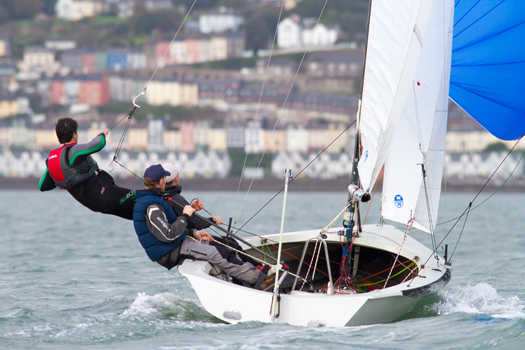
The big stories in Irish dinghy racing in 2015 will be the arrival of the new National 18s at Crosshaven, and the revival of Dinghy Week there in late August. Here, in the Autumn of 2013, To Dwyer and Nin O'Leary test sail the prototype of the new 18 on Cork Harbour. Photo: Bob Bateman
The new Third Generation (or maybe it's fourth or fifth generation) National 18 may have been designed in England by Phil Morrison, and is being built there too. But it was the very active Crosshaven fleet with the Royal Cork Yacht Club which led the charge towards a new boat, and when it came to stepping up to the plate to pay twelve substantial new boat deposits to move it all along after the prototype had been rigorously tested in Cork harbour last Autumn, it was the Crosshaven fleet that provided eight out of those twelve cheques.
So it's entirely appropriate that in August 2015, the dinghy focus will swing big time towards Crosshaven and a short form "Dinghy Week" from August 21st to 23rd. The old style Irish Dinghy Weeks – the last one was in 1970 – became victims of their own success, they just got too large. But the different classes became over-optimistic about their continuing individual growth prospects. Then the pendulum swung too far the other way, and dinghy classes were alone and their events shrinking. But a resurgence of club and championship dinghy sailing in Crosshaven during 2014, and a growing realization that over-reliance on single-handed dinghy classes does not necessarily produce a socially-adjusted national squad of junior sailors, resulted in some clear and creative thinking about developing two-handed boats, and reviving some old classes such as the Mirrors.
The form of this new Dinghy Week is still in the melting pot, but at least eight classes have responded with enthusiasm. Meanwhile, the National 18s in Crosshaven will be such a focus of interest during 2015 with the first of the new boats making their debut that we'll have a season-long dinghy narrative developing on Cork Harbour, and the revived Dinghy Week will be just part of it.
As for inshore keelboats, the big one in terms of number is the combined British and Irish Championship Squib Championship at Howth from 27th June to 3rd July. The handy little Squibs are something of an oddity, as they serve so well as a cherished local class in so many Irish sailing centres that many owners see them as that, and nothing more – handy little club sailors to be raced on home waters a couple of times a week.
This means that when a major regional or national event is held, the number taking part will often only be a fraction of the total Irish Squib fleet. But for those who do make the trek, the competition is fierce and the racing great – in Howth, the high point was in 1996, when this "Nationals" event attracted a fleet of exactly a hundred boats, and on one never-to-be-forgotten morning, there they were, every last one of them on the starting line.

A hundred Squibs all in a row at Howth on Tuesday July 25th 1996. Photo: Mandy Murnane
The most recent Squib event of national stature was the Freshwater Keelboat Regatta at Dromineer on Lough Derg on the weekend of October 18th-19th, and the battle for the top places was between the Kinsale and Belfast Lough fleets, with James Matthews and Rob Jacob of Kinsale rounding out their year in style with a good win.
But with the Squibs in England undergoing a revival – they were the second-biggest One Design fleet in Cowes Week 2014, bested only by the legendary XODs – there's no doubt there's a strong challenge coming across channel, and any Irish boat getting into the top ten will be doing well.
As for that annual Autumn Freshwater Keelboat Regatta at Dromineer, while it may have been much hampered by the spinoff from some ferocious weather out in the Atlantic with frustration for some of the sixty boats hoping to take part, it's an event of enormous potential, and the many who wish it well and have enjoyed it in the past will be ready and willing to do their part to make 2015's regatta a success.

The Squibs enjoying a lull in the strong winds during the Lough Derg Freshwater Regatta 2014. Overall winner was Mucky Duck (no 51, James Matthews & Rob Jacob, Kinsale YC). Photo: Gareth Craig
All these specialised and localized events planned for 2015 will be the continuing background music to the usual events of national sailing focus, everything from the selection of the Irish team for the Student Yachting Worlds to the Helmsmans Championships to the steady increase in pace while 2015 develops as the pre-Olympic year. As the year rolls along, other stories will develop too. So perhaps it's appropriate that we exit this review as we entered it. Just pause to remember now and again that, a hundred years ago, you simply couldn't have gone freely afloat like this for sport and recreation at all.
But we can't close on such a solemn note. Seasoned Solent sailors may have noted our header photo from Guido Cantini at the Panerai Classics Regatta was looking just slightly odd, for some reason difficult to pin down. Well, as it happens, the photo was sent to us back in September just as we were contemplating the excellent cleanup up done by Jason Hurley of Jason Hurley Design on the Mercedes-sponsored billboard photo of Howth 17s on the end wall of Howth Yacht Club. As with many photos taken over the RYS starting cannons, the Cantini pic included an obtrusive part of the Fawley Oil Refinery across on what Isle of Wight people call "the north island". Though Fawley has been there for yonks, it still has the look of a temporary structure. So we got Jason to treat as just that. But here for your edification is the true picture. You could get a taste for this sort of thing. What about brushing out Whitegate, lads? And as for Milford Haven.........
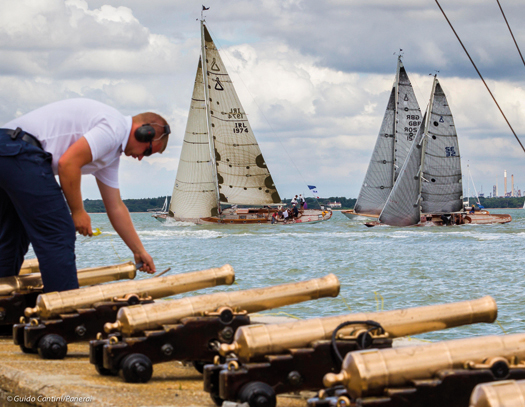
The unvarnished truth. In real life, the view from the RYS battery at Cowes can be slightly marred by the clutter of Fawley Refinery across the Solent on "the north island". Photo: Guido Cantini/Panerai
Read also: 2015 Irish Sailing Fixtures List (provisional)
RORC Lifts 100–Foot Limit for Fastnet & Middle Sea Races
Fastnet – The 100 foot (30.47m) LOA monohull limit set by a number of the classic 600 mile races such as the Fastnet, Sydney Hobart and Middle Sea races has been lifted by the Royal Ocean Racing Club and the Royal Malta Yacht Club for the 2015 editions of the Rolex Fastnet and Rolex Middle Sea Races. This will allow superyachts participating in the Atlantic Ocean Racing Series to compete.
The AORS consists of four events: the RORC Caribbean 600, the 2015 Transatlantic Race from Newport to the Lizard, the Rolex Fastnet Race and Rolex Middle Sea Race. Superyachts have always been eligible to race in the RORC Caribbean 600 and a number have entered for the west to east Transatlantic Race at the end of June/July 2015, organised by the Royal Yacht Squadron and New York Yacht Club in association with the Royal Ocean Racing Club and Storm Trysail Club.
In previous editions of the Rolex Fastnet Race only monohulls of 100ft or less were eligible to win the coveted Fastnet Challenge Cup. In 2013 there were two monohulls at this upper limit of 100ft: Mike Slade's Farr 100, ICAP Leopard (GBR), and Igor Simcic's RP100, Esimit Europa 2 (SLO).
With a number of superyachts competing in the 2015 Transatlantic Race, such as Elena Ambrosiadou's, 289ft Dykstra/Perini Navi, Maltese Falcon, and Mariette, the 1915 Herreshoff classic, the increased LOA limit for the 46th biennial Rolex Fastnet Race will entice yachts over 100ft to enter and possibly win the Fastnet Challenge Cup, making for a spectacular race from Cowes, Isle of Wight in August 2015.
Rolex Fastnet priority for RORC members
"Another initiative in place for the Rolex Fastnet Race is to give RORC members priority when entering in January 2015," explains Nick Elliott, RORC Racing Manager. "The race was oversubscribed in 2013 within 24 hours of entry opening with many boats, including those of RORC members, having to go on a waiting list. To cope with demand, the Club increased the limit to 340, but with the 2015 Transatlantic Race from Newport to the Lizard having close to 60 boats and the Rolex Middle Sea Race breaking the 100 boat barrier, we can only envisage another scramble for places when entry opens at midday on the 12th January 2015," continues Elliott.
Wise Decision to Hold Calves Week Fastnet Race A Day Early
#calvesweek – As indicated yesterday (Tues), the Cork Dry Gin Calves Week Organising Committee decided to run the showpiece race of the week a day earlier than had been planned, and yesterday the six racing fleets set sail out through Roaringwater Bay to the Fastnet Lighthouse writes Claire Bateman. After a slight delay to the start to ensure the full fleet had assembled.
With a fair forecast, and a steady 15 knot northwesterly, Race Officer Neil Prendiville ensured a full day's racing for all. He sent the smaller boats in Whitesail 2, who were started first, and Class 4 around the Amelia and on a fast close reach out directly to the Fastnet Rock and back. Whitesail 1, and Class 3 included a windward leg through the Calf Islands and around a laid mark south of Long Island, before the turn towards the Rock. Classes 0/1 and 2 had to complete a further downward/windward leg from the Fastnet Rock around Clear Island, and a blustery run north through the Gascanane Sound and northwest around West Calf Island for the Class 2 fleet and Goat Island for the largest Class 0/1 boats before a spinnaker run to the finish.
Royal Cork's Colman Garvey in True Penance won IRC Class 0/1 ahead of WHSC's Rob McConnell in Fools Gold and yesterday's winner, Kinsale's Conor Doyle, in Freya. In ECHO, three different boats took the spoils, with Peter Boylan's Sweden 45 , Annabella RIYC, ahead of Tom Roche's Meridian from Kinsale and local sailor Gabby Hogan's Grand Soleil 43, Growler. In Class 2 IRC, The McEneff/Madden/Hobbs Dexterity from Foynes YC won the day ahead of local rival Big Deal Derek Dillon, also fromFoynes YC and John O'Regan's The Main 4 from Kinsale. In ECHO Royal Cork's Ernie Dillon on Silke Breeze scored one up on his brother's result in IRC, ahead of The Main 4 and Raphael Crowley's Huntress from Tralee Bay.
The different racing conditions suited different boats in both Class 3 and 4. Dungarvan's Dan O'Donovan on Seconds Count was ahead on corrected time of both Gary Fort's J24, Jaguar from Tralee Bay and Jimmy Nyhan of Royal Cork on Outrigger. Bombora had a great win in ECHO Class 3 with Kinsale's Padraig O Donovan on Chameleon having a great regatta to date with a second placing in ECHO ahead of Frank O'Hara's, SHSC First 300, Chinook.
Michael Murphy's Shelly D won Class 4 IRC and was placed third in ECHO behind two local rivals, Schull's Kevin Murray on Dovita of Colla and Oonagh Buckley on Tete a Tete (SHSC).
In the fleet of larger whitesail boats, John Downing in Samba (RCYC) received his second first place in IRC ahead of the Roche/O'Leary/Andrews Act 2 and Bob Rendell's Samaton. ECHO honours went to Royal Cork's Conor Phelan in Endeavour ahead of Ken Burke from Howth Yacht Club on Savarna and Don McCarthy on VSOP (SHSC). In Whitesail 2, Tom McCarthy on Ashanta again took IRC honours, with local boat Dreamcatcher Frank Murphy, SHSC ahead of Michael Hearn on Summerfly and Cork boat, Tuna Brendan Buckley, RCYC.
Light winds are forecast for the remainder of the regatta, but as ever who can really tell and West Cork can be full of surprises.
Kenefick Prepares 'Full Irish' For Second Leg of La Solitaire Round Ireland's Fastnet Rock
#lasolitaire2014 – Leg Two of the 2014 Solitaire du Figaro is upon us. We are currently in balmy Plymouth with incredible weather about to be given the race briefing for the next leg. 535 miles from here to our very own Fastnet Rock and back to Roscoff. Exciting for me as any leg is but especially because we are going to be close to home for me. I sailed around the Fastnet Rock in the Fastnet Race last year with Olaf Sorensen but that was two-handed. This of course is different. 39 boats in the fleet, all of us on our own and all of us fighting for places in the most important race of our year.
So what's it going to be like? Well all of us are enjoying major summer weather which inevitably means not too much wind. It's going to take a long time. Although we will have reaching and spinnaker conditions for most of the way out and back it isn't going to be physical, it will be mental. There are a few obstacles on the way some of them real and some of them virtual. We have to respect the Traffic Separation Zones of which there are three large areas to the West and South of Lands End, at the Fastnet Rock and North of Ushant. If we stray into there areas it is instant disqualification. But we can only see them on our navigation charts and computer screens. There are no lines on the water!
We will start in Plymouth with an hour long inshore element around the buoys in Plymouth Sound before heading out to the West. The start is at 18:30 on Saturday, just as the local sea breeze is dropping off and the gradient is re-establishing itself from the other direction. So eventually Northerly going North East 10-15 knots all the way to Ireland.
I'm pretty sure the wind will drop considerably as we approach the Rock as it is almost coincident with the centre of the high pressure you are enjoying this weekend and next week. We will have to be careful as there will be light winds and transitions from gradient to sea breeze as we approach the Irish coast. We will make landfall somewhere between Castletownsend and Loch Hyne as we have to round The Stags South Cardinal buoy before making our way to the Rock. The reason for this little detour is to keep us safely away from the Traffic Separation Zone just to the South of the lighthouse. There may not be any wind and plenty of strong current flowing which might take us into the TSS, and that would mean instant disqualification. No messing. So if you around on Monday morning in that part of the world look out for the boat with the tricolor and the shamrock on the mainsail...
The way back to Roscoff from the Fastnet is the best part of 300 miles in a straight line. That's a long way in a straight line and the further we go the windier it will get which basically means those who are infront will go faster earlier. It will turn into a beat at the end in quite a bit of breeze and we should arrive in Roscoff sometime on Wednesday.
Fastnet Race Won by Father & Son Double–Handed Crew
#Fastnet – For the first time in its 88–year history, the Rolex Fastnet Race has been won by a double–handed crew.
The father and son team of Pascal and Alexis Loison from Cherbourg, France on the JPK 10.10, Night and Day, arrived at 07:19:57 BST this morning making their elapsed time 3 days 18 hours 29 minutes and 57 seconds for the 611 mile race.
Winning the overall IRC prize in the Rolex Fastnet Race means that Pascal Alexis Loisin will receive the Fastnet Challenge Cup as well as a Rolex Chronograph.
History has been made at the Rolex Fastnet Race. Pascal and Alexis Loison's JPK 1010 Night And Day from France has won the 2013 edition and is the first doublehanded crew ever to do so. A remarkable, near unthinkable achievement, which sets a new milestone for the mythical 88-year old race.
Arriving in Plymouth at 07:19 BST Thursday morning after four long nights at sea, Night And Day enjoyed a blistering return leg from the Fastnet Rock. In the process the dynamic duo overhauled the corrected times posted by the crews arriving ahead of them and left no room to overtake for those still on the course. Victory represents a historic feat for the father and son from Cherbourg whose unforeseen triumph is a pure demonstration of teamwork, determination and preparation.
"Nobody said this was impossible to achieve," reflected Pascal. "It's extraordinary, like a dream. I am very happy to have won this race with my son. There are so many factors required to make it happen. We simply hoped to win the two-handed class. This is superb."
"(The Rolex Fastnet) is one of the most prestigious races in the world, with some of the most refined boats there are," said Alexis, a professional sailor and regular single-handed Figaro competitor. "We competed against over 300 boats, many professional with big crews. Our preparation was really good."
Victory crowns an already successful season for the two who have only owned the boat since February. "This is our second Rolex Fastnet together," explained Pascal. "We know the English Channel very well having done a lot of races here. The racecourse is very complicated and fascinating. There is always something to think about at each point, turn, bay."
Night and Day's closest rival on the water was fellow French JPK 1010 Foggy Dew which crossed the finish line in Plymouth seven minutes later. "We found ourselves in a battle with them for first place," reflected Alexis. "They are guys we know well, our friends, who are very experienced and a worthy rival."
Offshore yacht racing is gruelling; a mental and physical challenge even for the crews with the most resources. Double-handed sailing is even tougher. Alexis revealed a simple strategy for conquering the inevitable fatigue: "During moments the boat was going well, we would take it in turns to rest. There is no rigorous organization (or watch system)." Confidence in their approach is natural: "It comes from sailing together for a long time."
The pair's only regret is that they did not experience a dramatic view of the Fastnet Rock. "Every time we pass the Fastnet it's foggy," joked Alexis. "I'm not sure if it really exists!" "It was raining with 300m of visibility," added Pascal. "We only saw the beam of the lighthouse. There were boats everywhere, stunning. It wasn't a great advert for Ireland but a wonderful, quite surreal memory."
Night And Day's victory heralds a dominant performance by the over 50-strong French boats in this year's Rolex Fastnet Race. The top five boats and twelve of the current top 15 finishers on corrected time are from across the Channel.
This is a victory that fully captures the spirit and ethos of the Rolex Fastnet Race. "The most important thing is that the race can be won by anyone," said the Royal Ocean Racing Club CEO Eddie Warden Owen. "Everyone thinks the professional, big boats are going to have an advantage but the 2013 race has just proved what the appeal of the Rolex Fastnet is all about. They are all here because they know they have a chance of winning."
By 17:40 BST, 244 of the 336-strong international fleet had crossed the finish line in Plymouth. All remaining yachts have rounded the Fastnet Rock, including the last placed Duet and the 100 year-old former winner, Jolie Brise. There have been ten retirements.
The final prizegiving will be held on Mount Batten, close to the Rolex Fastnet Race Village at 17:00 BST on Friday, 16 August 2013.
The writing was on the wall when they claimed the RORC Channel Race outright at the end of July, but the French father and son team of Alexis and Pascal Loison have pulled it out of the hat again, successfully winning the 2013 Rolex Fastnet Race.
While the Royal Ocean Racing Club's premier offshore event has featured a doublehanded class for a long time, this is the first occasion in its 88-year history that the Rolex Fastnet Race has been won by a doublehanded crew.
Night And Day, the Loisin's 33ft long JPK 1010, crossed the finish line off Plymouth Breakwater at 07:19:57 BST this morning (Thursday 15 August), with an elapsed time for the 611-mile course of 3 days 18 hours 29 minutes and 57 seconds. Under IRC, their time corrected out to being 33 minutes and 17 seconds ahead of the second placed yacht, another example of the French-built JPK 1010, Noel Racine's Foggy Dew.
Stronger winds and less headwinds later in the race certainly benefitted the smaller boats, but the JPK 1010 is clearly a competitive boat under IRC - five finished in the top 11 under IRC this year. "The JPK is an excellent boat in every condition - both upwind and downwind," agrees Alexis.
However the Loisins are clearly special too. Their victory this year follows competing in the 2005 Rolex Fastnet Race aboard their previous Night And Day, a J/105, when they again won the doublehanded classes and were second overall in IRC Two.
From Cherbourg, Pascal, 53, is a surgeon while his son Alexis, 29, is a professional sailor who has spent the last eight years competing in the Figaro class. In La Solitaire du Figaro, effectively the world championship of solo offshore racing, his best result has been eighth last year, and ninth this year.
"Alexis is a very nice guy - he's low key, but good fun and performs very well in the Figaro," describes Gilles Chiorri, Race Director of La Solitaire, who competed in the Figaro class in this year's Rolex Fastnet Race. "And the conditions we had weren't easy for doublehanded crews - a long reach under spinnaker, which is not easy to manage with only two on board."
Many top Solitaire du Figaro sailors competed in this year's Rolex Fastnet Race, including 2012 and 2013 winner Yann Elies, racing on the IMOCA 60 Cheminées Poujoulat, triple winner Michel Desjoyeaux, who was on the IMOCA 60 MACIF, while another double Solitaire du Figaro winner, Armel le Cleac'h, skippered the maxi-trimaran Banque Populaire.
"I think the boat is a good reason," says Alexis of why they won. "Plus we sail together all the time and we have good tactical knowledge - our tactics were good all the time. We made sure we slept well and we had good weather."
Otherwise, compared to the fully crewed JPK 1010s, Alexis said he couldn't put his finger on why they performed better than the fully crewed boats. "With Foggy Dew, it is not the tactics, I think we have a better spinnaker and speed."
During the race the toughest decision they had to make was over which side of the Traffic Separation Scheme (TSS) they should go around off Land's End.
While it is Pascal's boat, Alexis is a professional sailor, so come crunch time, who makes the decision?
"Over big decisions we talk...but we don't always agree," admits Pascal. His son nods: "We talk..."
In the end they went north up the west side of the TSS, then tacked to head west leaving the Scilly Isles to port. When they tacked back to north for the Fastnet Rock it was into a big lift that caused them to sail a beautiful parabolic towards the turning mark.
After rounding the Pantaenius spreader mark, it was "fast, but not furious" as Alexis jokes. "We came back from Fastnet very fast under the small spinnaker. It was a great moment."
Like all the fast smaller boats, the passage to Bishop Rock was a tight reach, followed by a run down towards the Finish - both legs sailed directly to the mark and in good breeze, unlike the stop-start-stop sailing the bigger boats experienced on this part of the course.
A significant result
Eddie Warden Owen, CEO of the RORC was amazed by the Loisins' performance. "I think they have done a brilliant job. It is the first time that in the history of the race a doublehanded boat has won the race, so that is a very significant result.
"Night And Day's amazing achievement for me is that in a very tactical race they beat a fully crewed boat - and a really good one - of the same type." Foggy Dew was second overall this year and second in IRC Three in 2011.
However Night And Day's victory also highlights that it is still possible for well sailed small boats to win the Rolex Fastnet Race, just as the last French overall winner, the Nicholson 33, Jean-Yves Chateau's Iromiguy, did in 2005.
"That's one of the reasons the Rolex Fastnet Race is so successful," continues Warden Owen. "For people, family and friends, sailing in the middle of the pack and at the bottom, it is not just a challenge - they have a realistic chance of winning."
For their efforts Pascal and Alexis Loison will be awarded the Fastnet Challenge Cup as well as a Rolex Chronograph at tomorrow night's prize giving.
Fastnet Fortunes Changing for Round Ireland Champion, Inismor
#fastnet – As the miles are whittled away and the bulk of the fleet converges on the Plymouth breakwater finishing line, Irish interests in podium positions are best represented by Inis Mor (Ker 39, Laurent Gouy, Clifden BC), who is 7th in IRC overall and 2nd in the IRC1 class.
Discover Ireland (Reflex 38, Aodhan Fitzgerald, GBSC), is 18th overall and 6th in class, while Spirit of Jacana (J/133, Alan, Bruce & James Douglas, Carrickfergus SC) is 26th overall and 10th in class and Antix (Ker 39, Anthony O'Leary, RCYC) is 30th overall and 12th in class.
At teatime, Galway's Fitzgerald reported into Afloat.ie : ' Just around the Bishop [rock]. Kite up now for Lizard. We chose the easterly option around tss on way home. Boat very wet after today and last night. Truly miserable night at Fastnet.
There is a good showing by Lula Belle (First 36.7, Liam Coyne, NYC) who is 16th in the two-handed division.
With the wind forecast to be relatively steady or increasing over the night, there is unlikely to be any "parking up" that could give rise to an upset in the predictions, unlike the Dun Laoghaire Dingle race earlier this summer.
It's looking likely to be an all French podium with MC34 Patton Courrier Vintage followed by the 2 JPK10.10s – Night and Day and Foggy Dew, the former's performance remarkable in that there are only two crew, making them a shoo-in for top honours in the two-handed division.
RORC Update:
Doublehanded IMOCA 60 leaders finish less than a minute apart, ahead of Mini Maxis and VO70
Hiding amid the big monohull finishers that arrived into Plymouth this morning in the Rolex Fastnet Race's, the closest was between the top IMOCA 60s.
Vendée Globe winners François Gabart and Michel Desjoyeaux on the former's MACIF and her sistership Maître CoQ (formerly Armel le Cleac'h's Banque Populaire), sailed by Jérémie Beyou and Christopher Pratt, crossed the line off Plymouth breakwater, separated by just 57 seconds after 611 miles of racing.
Most impressively MACIF, sailed doublehanded, arrived at 07:32:19 BST this morning. To put this into context, on the water she beat both of the leading Mini Maxis, Bella Mente and Rán 2, as well as the VO70 Team SCA; all of these boats at least 10ft longer and being sailed with a full crew.
Alex Thomson and Spaniard Guillermo Altadill on Hugo Boss, arrived six minutes after MACIF, behind Team SCA but still ahead of the Mini Maxi. By coincidence this IMOCA 60 podium was the same as this year's Vendée Globe, with Alex Thomson doing an excellent job to hang on to the coat tails of the newer VPLP-Verdier designs.
This was the first major event for Gabart, since he won the 2012-3 Vendée Globe in February. "Of course, it is always a pleasure to win," he said. "But mostly it's nice to get back to some sailing! Plus, when it is with Michel [Desjoyeaux] it's just perfect. We still have to tweak a few details, but we have already seen that the work done this winter is going in the right direction. With the new mast, we have gained some extra speed."
Gabart observed that not only was the finish order identical to the Vendée Globe podium, but also the difference between the finishers. "It promises for an interesting Transat Jacques Vabre."
Second placed Jérémie Beyou commented: "We were second for almost the entire race - that was really good. We sailed well tactically, but François and Michel are faster. At the Fastnet Rock, we crossed MACIF, and she was well ahead of the rest of the fleet. But when we cracked off, the other competitors caught us up."
Alex Thomson agreed that the repeat of the Vendée podium was strange. "Guillermo and I felt we sailed a very good race. There were times when we struggle a little bit compared to the new boats."
Their crossing of the Celtic Sea was intelligent and in their older generation IMOCA 60, Hugo Boss, they rounded the Fastnet Rock two miles behind the front runners, falling back further, to trail them by six miles at Bishop Rock.
They made up ground on the approach to Plymouth. "It was a crazy finish!" recounted Thomson. "When we came round Ram Head we were only expecting to see a couple of boats and we could see ICAP Leopard and everyone was right there!"
They ghosted across after overhauling some potentially much faster fully crewed boats. "It was a very tactical race," Thomson concluded. "We didn't make any mistakes but we didn't benefit from any luck either. I am really happy."
Meanwhile, back on the race course...
At present, of the 336 starters, there have been just eight retirements, the last being the Nicholas 43, Emily. There have been 21 finishers in the IRC fleets and 13 in the non-IRC boats.
Of the boats that have finished, Johnny Vincent's 52ft Pace is on top followed by Vincente Garcia's Swan 80 Plis Play (the top two boats in IRC Zero) and the Nicolas Groleau-skippered Cartouche, the winner in IRC Canting Keel.
Jules Salter, navigator on Pace, said that the crew was confident in their performance downwind against the competition. The only issue was that three quarters of the race were upwind - even after passing the Fastnet Rock they were tight reaching after the wind backed into the south.
Unlike the bigger boats, Pace rounded Bishop Rock in 15-20 knots of wind and from there had a fast run to the finish at Plymouth breakwater. So will they win? "I think the little boats will do it - they reached in and reached out from the Fastnet Rock," said Salter. "We'll win our class hopefully."
After the French 1-2 in the IMOCA 60 class, another Breton boat, Cartouche, skippered by Nicolas Groleau, ended up beating the Maxis, Mini Maxis and VO70s to the IRC win in the Canting Keel class. Groleau runs the JPS Production boatyard in La Trinité-sur-Mer, and Cartouche is an example of the biggest boat they produce - the Sam Manuard-designed Mach 45.
With a crew from La Trinité, including round-the-world sailor Ludovic Aglaor, Groleau also complained about there being too much upwind work in this Rolex Fastnet Race, despite seeing the wind back into the southwest en route to the Fastnet Rock. Their win in IRC Canting Keel was down to their fast finish. "Coming into the Bishop Rock we were very fast, reaching at over 15-16 knots and then it was downwind from the Scillies to Plymouth, full speed under spinnaker at 20 knots, always over 16. I imagine the big boats in our class were very slow around the Scillies, at Land's End and when they finished."
It was generally a good day for Groleau's company. It also made the Rolex Fastnet Race winning Class 40, Sebastien Rogue's Mach 40, GDF Suez.
Of the boats still at sea, three boats have been doing consistently well today in Gery Trentesaux's Courrier Vintage and Andrew Pearce's Ker 40 Magnum III and Laurent Gouy's Ker 39 Inis Mor.
Having shipped his boat all the way from Australia to compete, Goeff Boettcher was pleased with the third place for his Reichel Pugh 51, Secret Men's Business 3.5 in IRC Zero.
"It was a great race. It is a pity there was so much on the nose work and at the Fastnet Rock we ran into a no wind situation," said Boettcher. "If we'd had a bit more running and reaching... but overall I think we ended up where we thought we would."
Boettcher now plans to ship the boat back to Australia for this year's Rolex Sydney Hobart. "I'm glad we did the Rolex Fastnet Race - it is totally different, a lot of scenery. There are a lot of places to go and see! I was surprised - the seas were quite flat. Coming to new places on the yacht is cool."
#Fastnet – Anthony O'Leary's Ker 39, Antix, rounded the Fastnet Rock on 13 August at 19:10:54, an emotional moment for the all-Irish crew. From the bow to the stern of the boat, Antix personifies the long history and passion of the Rolex Fastnet Race.
On the bow, 22 year-old Jamie Donegan is the fifth generation of his family to have taken part, Henry Donegan having competed in the first Fastnet Race in 1925, aboard Gull, which was built in 1895 as WM Nixon recounted in his Sailing on Saturday blog last weekend.
"Henry Donegan was my great great Grandfather and on board was his son, also called Henry; it's a bit of a family name," smiled Jamie. "It wasn't until 1983, that Yellow Scampi raced around the Rock with Jim Donegan and his son Peter on board and I am the fifth generation to take part. I have been on the bow of Antix for the last two years and I have grown up with Anthony O'Leary's son Robert.
"The Fastnet Rock is so close to my home and it will be hard to turn around and go back, but I intend to do my family proud and enjoy the race and hopefully, this race will be the first of many."
Jamie Donegan may be the only sailor in the Rolex Fastnet Race to count a five-generation Fastnet affair but Peter and Robert O'Leary are the fourth generation of their family to have competed in the iconic race as their father, and skipper of Antix, Anthony O'Leary, explains.
A marriage of yachting dynasties
"This will be my first Fastnet since 1977. My wife Sally competed in the notorious 1979 race. She is the daughter of Sir Robin Aisher and by that lineage, Robert and Peter are fourth generation competitors. I proposed to Sally straight after the 1979 race and we have three boys from our marriage but this year is the first time I have taken part in the Fastnet Race with any of them. When we pass the Rock, we will be just 3 miles from Cape Clear and I am sure we will hear the clinking of glasses in Baltimore, as we round the Rock."
As Antix rounded the Fastnet Rock on Tuesday evening, Sally O'Leary was there, in appalling weather, cheering on her husband, her sons and the proud Irish crew on board. "I didn't shed a tear but it is a moment I will never forget; watching them in the rain, hiking hard after a 400-mile beat. To be honest I was happy not to be on board.," observed Sally, as Antix turned back across the Celtic Sea, to finish the 45th edition of the Rolex Fastnet Race.
Antix has three Baltimore Lifeboatmen amongst the crew, who assisted in the rescue of the Rambler 100 crew in the 2011 Rolex Fastnet Race.
Antix crew: Anthony O'Leary, Pat Collins, Cathal Cottrell, Fred Cudmore, Jamie Donegan,Youen Jacob, Ross McDonald, Darragh O' Connor, Robert O'Leary, Peter O'Leary, Ian Travers.
#fastnet – With the smaller boats returning from the Fastnet Rock in better conditions, they are becoming increasingly favoured for the overall win of the Rolex Fastnet Race under IRC. Andrew Pearce's Ker 40, Magnum 3, was ahead first thing this morning, but has since been overtaken by Inis Mor, the Ker 39 of Frenchman Laurent Gouy. It could be at least another 48 hours before a winner of the Rolex Fastnet Race 2013 is finally decided.
Maxi-monohull match races play out
Like the animals in Noah's Ark, the biggest monohulls have spent the last days travelling two by two around the Rolex Fastnet Race course.
Between the pair of 100ft long Maxis - Esimit Europa 2 and Mike Slade's ICAP Leopard - it was the more nimble European maxi that led around the course to claim monohull line honours, finishing at 02:17:49 BST, with an elapsed time of 2 days 12 hours 27 minutes and 49 seconds.
Weighing in at a svelte 27 tonnes, compared to ICAP Leopard's 50, Esimit Europa 2 was the pre-race favourite for monohull line honours win and, after being forced to retire from the 2007 Rolex Fastnet Race in her previous incarnation as Neville Crichton's Alfa Romeo, this time she didn't disappoint. According to her skipper, multiple Olympic medallist Jochen Schümann, the Esimit Europa 2 crew was concerned sailing down the Channel, because the moderate to strong upwind conditions favoured ICAP Leopard. In fact the closest ICAP Leopard got to them was around a mile.
Then, Schümann recounted: "At the Scillies we made a big gain and at the restricted area next to the Fastnet, we split - we went to the west, and then reached around the Rock, while they went east and there they lost quite a bit. We were 15 miles ahead at the Fastnet Rock. From then, it was like a bungie - we stopped, they stopped, etc."
The race was relatively simple in terms of crew work - there was only one jib change outbound to the Rock on board Esimit Europa 2, and downwind on the way back the conditions never exceeded 12 knots. But after all the hard work around the course, the outcome was only decided in the last moments when, like so many night time arrivals, Esimit Europa 2, was becalmed on the approach to the finish, as the boats behind approached, bringing the wind in with them.
"It would have been very easy to stop and let some other people come with momentum and pass you, but we passed the headlands in the right place and stayed in some breeze. It was much more difficult than I remember in the past," said Schümann.
Esimit Europa 2's owner, Slovenian businessman Igor Simčič, commented: "The Rolex Fastnet Race is a very important race, a very long race - it is a test of many things, not only a boat and crew. I am very happy to have such a boat and such a crew that know how to manage this potential."
"At the beginning I was expecting to have more wind, because the Fastnet is known for very strong wind, but even in this case it wasn't so easy. I also very much appreciate the effort of all the other boats - the smaller ones who will be spending four or five days at sea to complete the race."
Frustrating park-up
If Esimit Europa 2 suffered a slow down approaching the finish line, it was far worse for ICAP Leopard, as Mike Slade's line honours winner from 2007 and 2009 was becalmed off the finish for the best part of two hours, as boats closed in from behind.
Much to the chagrin of the ICAP Leopard crew, they were once again beaten by the Ian Walker-skippered team on the Abu Dhabi Ocean Racing VO70, which pipped them to the post crossing the line at 07:25:03, just four and a half minutes ahead of them.
"There was no wind as is often the case," explained Walker, the double Olympic silver medallist. "There was a bit of land breeze in the harbour and Leopard was completely marooned. We came in with the new wind from behind. The same could have happened to us, but fortunately we managed to get ourselves into a position where we went around the outside, away from the cliff."
Ian Walker, Skipper, Abu Dhabi Ocean Racing.Credit: Rolex / Daniel Forster
Of greater consequence for the Abu Dhabi team is that they successfully fought back from being more than five miles behind the women's team on Team SCA at the Fastnet Rock, to regain the lead just coming into Bishop Rock.
Team SCA navigator Sam Davies admitted that returning from the Fastnet Rock they had made a mistake in heading too far east in light winds allowing Abu Dhabi to make a big gain. "Then once we were near each other it was pretty clear that we were missing a spinnaker. They have an inshore free-flying spinnaker, which we did not - so they were sailing lower and faster all the way down there."
Ian Walker agreed that the speed difference came down to this sail, but it also represented the 39 point difference in IRC rating which ensured Team SCA beat Abu Dhabi on handicap and yesterday afternoon Team SCA not only led the IRC Canting Keel class, but the Rolex Fastnet Race in its entirety. However this morning, with the smaller boats returning from the Fastnet Rock, the overall lead has now shifted back to the 40 footers, while in IRC Canting Keel, the leader is the Baltic 78, Lupa of London, although one more boat in this class is still to finish.
The match race between the two Judel Vrolijk 72 Mini Maxis took a dramatic turn further back up the course. American Hap Fauth's newer and more powerful Bella Mente had led and extended over Niklas Zennström's 2009 and 2011 overall Rolex Fastnet Race winner, Rán 2, on the way to the Fastnet Rock.
"We were very happy with our beat, possibly because we are a bit more powerful, but we orientated the boat to beat them to the Rock," explained Bella Mente helmsman and former Volvo Ocean Race winning skipper, Mike Sanderson of their race with Rán 2. "We all know that if you can lead to the Rock, you are normally in pretty good shape." For example, this included taking 18 crew compared to the 12 they sailed with in the Giraglia Rolex Cup or the 16 for the RORC Caribbean 600.
After looking to be in good shape, Bella Mente suffered late yesterday afternoon when they fell into a patch of light wind short of the Bishop Rock. "The others were bringing breeze down - MACIF was doing 16 knots, Rán was doing 14 knots and we were doing 12 knots," explained Sanderson. This caused the fleet to compress and from holding a comfortable 8 mile advantage over Rán and leading IRC Zero, Bella Mente's lead reduced to 3.5 miles.
"We had a good race, it's just a bit of a shame we couldn't finish it off - the wind gods just weren't on our side," concluded Sanderson.
While Rán 2 succeeded in beating Bella Mente under IRC, she has been knocked into second place in IRC Zero by Johnny Vincent's TP52, Pace. Overall she holds third place under IRC and sadly is no longer in with a chance of entering the history books by securing her third consecutive overall win in the Rolex Fastnet Race.
Largest Fastnet Yacht Claims Monohull Line Honours
#fastnet – Jochen Schümann, Skipper of Esimit Europa 2, Maxi RP100: 30.48m (100ft) (SLO), crossed the finish line of the 2013 Rolex Fastnet Race at the Plymouth Breakwater at 02:17:49 on Wednesday, 14th August after an elapsed time of 2 days, 12:27:49.
The largest yacht in the IRC class, Esimit Europa 2, has so far claimed 25 line honours of all attended races, and set 6 course records.
At 17:00 BST she was 85-nm from the finish line in Plymouth, with the crew reporting an ETA of 01:00 BST Wednesday morning. In the prevailing light conditions, Esimit Europa 2 has a natural advantage over her nearest rival, Mike Slade's heavier ICAP Leopard (GBR) and consequently throughout the day has been able to build what looks like an insurmountable lead. It currently stands at 20-nm.
Volvo 70 Team SCA (SWE) is making good progress on the heels of ICAP Leopard currently finding itself in a strong position with the IRC rating system taken into account. "Since the Fastnet Rock we have been pushing into this lighter stuff," reported Team SCA's Brad Jackson. "The boats behind us keep coming at us but we eventually hit some breeze and keep getting away. We'll keep trying to do that for a while." It was the first time some of us have seen the Rock, which is pretty cool.
Among the chasing group is Bella Mente who continues to prevail in the clash between the two 72-ft Mini Maxis. Hap Fauth's American crew rounded the Fastnet Rock at dawn this morning and, despite having to repair a broken mainsheet, the crew were in good spirits, reporting: "It was the first time some of us have seen the Rock, which is pretty cool. Rán 2 rounded the Rock a good distance behind us so we need to build on that lead a bit more for the anticipated light air finish." Rán 2's slow passage around the Rock bordered on tedium. "All this hard work for a small rock in the [Celtic] Sea!," they jokingly blogged. "After rounding the Rock we are racing back towards Plymouth hopefully with more wind." Bella Mente continues to enjoy a 5-nm advantage, 140-nm to finish.
The bulk of the 336-strong fleet is still en-route to the Fastnet Rock, the 611-nm race's emblematic halfway point. It is proving a highly tactical, challenging race with numerous wind shifts to respond to. Crews are having to strategically manage their resources with many long hours at sea still forecast. Andrew Pearce's Ker 40 Magnum 3 (GBR) currently 10-nm from the Rock reported: "Last night was much colder, although the increased fatigue probably played a part. We are reduced to a three-watch system of two hours instead of three in order to make sure a fresh watch is always on deck. Nevertheless, the relentless pace and difficult conditions mean tiredness is relatively inescapable."
A sentiment likely to be felt throughout the fleet as they head into a third long night. At 17:00 BST, 29 yachts had rounded the Fastnet Rock. To date, there have been eight retirements.
Round Ireland Champion, Inismor, Leads Fastnet Fleet
#fastnet – Current Round Ireland race champion Inis Mor, sailed by French skipper Laurent Gouy with connections to Clifden Boat Club in Connemara in County Galway, leads the prestigious Rolex Fastnet race this morning in the approach to the famous rock turning point off the south west coast of Ireland.
Although multihulls completed the course in the early hours of this morning no less than 300–boats are still racing at the mid–point of the 605–mile course for the overall handicap prize.
This morning's leaderboard (at 0730) on the race tracker showed the Irish champion leading, heading 340 degrees and making a speed of 6.10 knots. In 2012, in another race off the Irish coast, Gouy produced a magnificent final leg in the Irish Sea to win the Round Ireland race off Wicklow.
In a race that has so far featured many challenges and changes in wind conditions, it is the second time Inismor has taken the lead in the massive offshore fleet.
In a further boost for Irish fans, Inismor's sistership, the Ker 39, Antix skippered by Royal Cork's Anthony O'Leary lies fifth overall in class and mounting a serious challenge for the lead this morning.
Meanwhile David Kenefick and Olaf Sorensen are ninth in class in the Figaro double–handers.






























